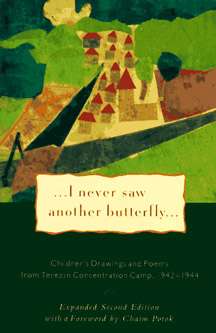I Never Saw Another Butterfly
I Never Saw Another Butterfly is a collection of works of art and poetry by Jewish children who lived in the concentration camp Theresienstadt. This book is named after a poem by Pavel Friedman, a young man born in 1921 who was incarcerated at Theresienstadt and was later killed at Auschwitz. Where known, the fate of each young author is listed. Most died prior to the camp being liberated.[1]
 Cover of I Never Saw Another Butterfly | |
| Author | Hana Volavkova |
|---|---|
| Country | Czechoslovakia |
| Language | English originally in Czech |
| Genre | History |
| Publisher | Schocken |
Publication date | March 15, 1994 |
| Media type | Print (Paperback) |
| Pages | 128 |
| ISBN | 0-8052-1015-6 |
| OCLC | 26214051 |
Terezin
During World War II the Gestapo used Terezin, better known by the German name Theresienstadt, as a ghetto. The majority of the Jews sent were scholars, professionals, artists and musicians. Inmates were encouraged to lead creative lives, and concerts were even held. Within the camp, parks, grassy areas and flower beds, concert venues and statues were installed to hide the truth; that most of the inmates were going to be killed. This was all part of a Nazi plot to deceive International Red Cross inspectors into believing that Jews were being treated humanely. This façade masked the fact that of the 144,000 Jews were sent there, about 33,000 died, mostly because of the appalling conditions (hunger, stress, disease, and an epidemic of typhus at the very end of the war) . About 88,000 were deported to Auschwitz and other extermination camps . At the end of the war there were 17,247 survivors .
Part of the fortification (Small Fortress) served as the largest Gestapo prison in the Protectorate of Bohemia and Moravia, separated from the ghetto. Around 90,000 people went through it, and 2,600 of those died there.
It was liberated on May 9, 1945 by the Soviet Army.
The Play
I Never Saw Another Butterfly is also the name of a one-act play by Celeste Raspanti.[2] It is also the name of a musical by a young man named Joseph Robinette.[3] The play centers around Raja, one of the children who survived Terezin, and her family and friends plus classmates. She shares her story of living in the concentration camp, while retaining a world filled with butterflies and flowers with other children in the camp...
Kirkland theatre Studio East has performed the play as a musical, with poems written by the children set to music.
See also
References
- ↑ aahelpdesk (May 21, 2009). "Holocaust Butterfly". Retrieved February 3, 2012.
- ↑ http://www.dramaticpublishing.com/AuthorBio.php?titlelink=9775
- ↑ http://www.dramaticpublishing.com/p1827/I-Never-Saw-Another-Butterfly-%28musical%29/product_info.html